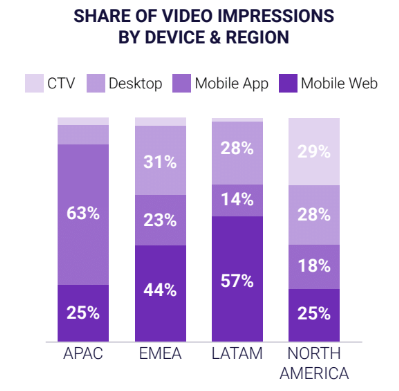CTV Takes Lead in Video Delivery With Fraud Rates Falling: DoubleVerify
Report sees quality of programmatic buys improving
Connected TV has become the No. 1 device for delivery of digital video in North America, according to a new report from DoubleVerify.
Total video impressions grew 56% during the 12 months from May 2020 to April 2021, compared to the previous 12 months. CTV impressions grew 87%, rising to a 29% share.

With marketers spending more of their ad dollars on CTV, the quality of programmatic buys is improving and matches direct buys through publishers.
Read Also: CTV Ads More Relevant to Consumer, Says Engine Study
The popularity and high price of CTV ads has attracted schemes to divert spending. But the rate of fraud and sophisticated invalid traffic (SIVT) for programmatic fell 31% to 1.4%, DoubleVerify said in its annual Global Insights report. Publisher direct buys also had a 1.4% violation rate, down 26%.
The brand suitability violation rate on programmatic buys fell 7% to 7.3%, while publisher direct buys had a 7.4% rate, up 10%.
Also Read: Connected TV Grabs More Time Spent Watching: TVision
The smarter way to stay on top of broadcasting and cable industry. Sign up below
“Private marketplaces (PMPs) and programmatic guaranteed deals (PGs) add flexibility to buys that blur the line between programmatic and publisher direct. It’s possible to now
buy from publishers programmatically. So it’s not surprising that quality is converging,” the report said.
Tools for buying CTV are still evolving. DoubleVertify said that this year it rolled out inclusion and exclusion lists for CTV, allowing advertisers to measure whether their actual placements match their media plans.
DoubleVerify also provides Video Filtering, which blocks brand suitability and fraud/SIVT violations on CTV. Advertisers using DV Video Filtering saw a 49% lower brand suitability violation rate than those who have not yet adopted the tool, the company said.
“Globally, post-bid fraud/SIVT and brand suitability violation rates are down while viewable rates are up. But that doesn’t mean advertisers should relax their standards,” the report concluded.
“One of the main reasons we’re seeing improvements in post-bid quality measures across the board is because of the prolific adoption of pre-bid programmatic protection. This means that much of the coverage is happening before the ad is purchased. Advertisers are combining pre- and post-bid coverage to ensure efficiency and effectiveness in their media buys,” the report said.
Jon has been business editor of Broadcasting+Cable since 2010. He focuses on revenue-generating activities, including advertising and distribution, as well as executive intrigue and merger and acquisition activity. Just about any story is fair game, if a dollar sign can make its way into the article. Before B+C, Jon covered the industry for TVWeek, Cable World, Electronic Media, Advertising Age and The New York Post. A native New Yorker, Jon is hiding in plain sight in the suburbs of Chicago.

